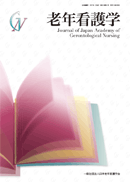Current issue
Displaying 1-9 of 9 articles from this issue
- |<
- <
- 1
- >
- >|
Original Article
-
2025Volume 30Issue 1 Pages 31-40
Published: 2025
Released on J-STAGE: August 15, 2025
Download PDF (1400K) -
2025Volume 30Issue 1 Pages 41-52
Published: 2025
Released on J-STAGE: August 15, 2025
Download PDF (1466K) -
2025Volume 30Issue 1 Pages 53-63
Published: 2025
Released on J-STAGE: August 15, 2025
Download PDF (1570K)
Brief Reports
-
2025Volume 30Issue 1 Pages 64-72
Published: 2025
Released on J-STAGE: August 15, 2025
Download PDF (1380K) -
2025Volume 30Issue 1 Pages 73-81
Published: 2025
Released on J-STAGE: August 15, 2025
Download PDF (1385K) -
2025Volume 30Issue 1 Pages 82-89
Published: 2025
Released on J-STAGE: August 15, 2025
Download PDF (1436K) -
2025Volume 30Issue 1 Pages 90-98
Published: 2025
Released on J-STAGE: August 15, 2025
Download PDF (1375K) -
2025Volume 30Issue 1 Pages 99-107
Published: 2025
Released on J-STAGE: August 15, 2025
Download PDF (1405K)
Case Report
-
2025Volume 30Issue 1 Pages 108-115
Published: 2025
Released on J-STAGE: August 15, 2025
Download PDF (1439K)
- |<
- <
- 1
- >
- >|
